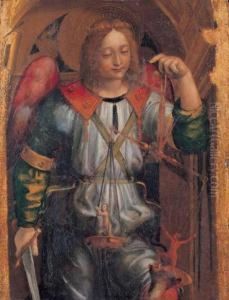Bernardino Zenale Paintings
Bernardino Zenale was an Italian painter and architect who played a significant role in the Lombard Renaissance. Born around 1460 in Treviglio, Lombardy, he was influenced by the work of artists such as Bramante, with whom he is thought to have collaborated. Zenale's early life and training are not well documented, but it is clear that by the late 15th century, he had established himself as a painter of considerable skill.
Zenale's work often combined the Lombard painting tradition with elements of the Venetian Renaissance, showcasing an attention to detail and a love of rich color. His paintings are characterized by their serene human figures and complex architectural settings. One of his most famous works is the Altarpiece of Saints Mark and John, which exemplifies his ability to integrate figures into a convincing spatial framework.
Throughout his career, Zenale also showed a keen interest in mathematics and geometry, which is evident in his architectural designs. He was an admirer of Leonardo da Vinci and was influenced by Leonardo's studies of perspective. This influence is visible in Zenale's careful arrangement of space and his use of architectural elements to create depth in his paintings.
In addition to his work as a painter, Zenale was also an accomplished architect. Although fewer of his architectural works survive, he is credited with contributing to the design of several churches and chapels in Northern Italy. His understanding of spatial composition and his ability to harmonize different elements of design are seen as a testament to his dual talents as an artist and an architect.
Zenale's later works continue to reflect his engagement with the major artistic trends of his time, including the High Renaissance style that was becoming prominent in Italy. His ability to adapt and evolve stylistically while maintaining his distinctive approach to painting and design helped to cement his reputation as a significant figure in the Northern Italian Renaissance.
Bernardino Zenale died in 1526, leaving behind a legacy that has been appreciated in art historical circles for his contributions to Lombard painting and his synthesis of artistic ideas that bridged the late 15th and early 16th centuries.
